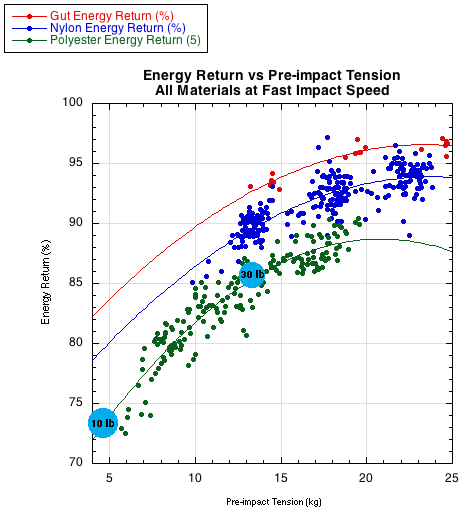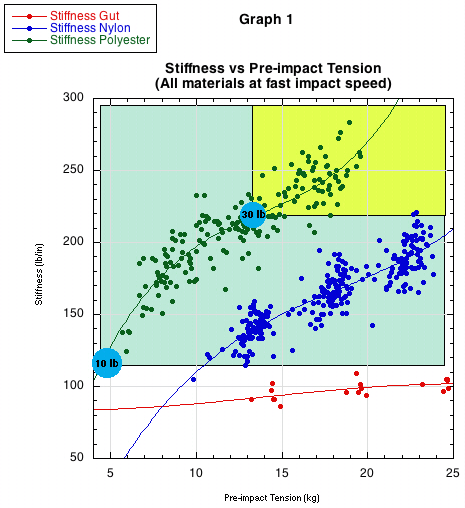Not exactly what you are looking for, but ...
As you can see on the energy return vs tension graph, poly has less energy return at all tensions compared to gut and nylon. What this means is a bit complicated. The question is this: does lower energy return from the strings mean less power (ball velocity)? The answer is that it may or may not. The efficiency of the strings is only part of the story. The other part involves string stiffness. The scenario looks like this:
Let's drop a ball on a secured racquet so that it will not move or bend on impact--only the strings and ball will interact (in a normal tennis hit, about two thirds of the energy goes into moving the racquet and about a third goes into the strings and ball deformations). Strings return energy that goes into them according to the graph (anywhere from about 73-97%). Let's say your string at your current tension returns 95% of the energy that goes into it. But how much energy goes into the strings? The strings and the ball divide up the available energy according to their relative stiffnesses. The softer of the two will get proportionately more of the energy of impact. So, if the stringbed and the ball are of equal stiffness, they will each take 50% of the energy. If the strings are half as stiff as the ball, then they will take in twice the energy (in other words the ball's share will be one third and the strings' share will be two thirds).
The ball returns about 55% of the energy that goes into it (depending some on the speed and angle of impact). The string we are looking returns 95%. What does this mean to our two cases above of a stiff setup and a soft setup?
If the the ball and strings are the same stiffness (which is a "close enough" assumption for conceptual purposes for most nylons strung in the 50-60lb range), then the ball will give back 55% of the energy, for a total of 27.5% return. The strings will give back 95% of 50% for a return of 47.5%. Added together we get a total return of 75% of the energy that went into the ball and strings. (FYI, the square root of energy return is power potential so here we have sqrt of .75 = .866 = power potential of 86.6%, which is so high because the racquet is clamped and does not lose energy in motion and bending)
If the strings are half as stiff as the ball, then we get 55% times 33% = 18.2% return from the ball and 95% times 66% = 62.7% return from the strings for a total return of 81%, which is 6% greater than if the string were twice as stiff (for power potential of 90%).
So lowering the stiffness of the strings compared to the ball lowers the amount of energy that goes into the inefficient ball and raises the amount that goes into the more efficient strings. But our graph shows that lowering the strings stiffness also lowers its energy efficiency. So it is somewhat of a trade-off. The stiffer setup has better string efficiency but has less energy to work with. The softer setup has lower string efficiency but more energy to work with.
Long story short, even if you don't know the relative stiffness of the ball and strings, you do know that no matter what, decreasing string stiffness by lowering tension or changing to a softer string increases the energy flow into the more efficient strings compared to the less efficient ball. But that doesn't necessarily mean more power. To end up with more power, enough extra energy has to be transferred to the strings to more than make up for any decline in string efficiency due to lower tension or due to a change to an inherently less efficient string or material.
What you can see from the graphs is that poly is virtually always stiffer than other materials except at very low tensions and it almost always has less energy return. The combination means that you may get more power going from one poly to a lower tension in the same (or you may not depending on the trade off), but except in extreme setups, you probably won't get more power than other materials that are at the same or even higher tensions. Note: the yellow area in the stiffness vs tension graph is where the 30lb poly is softer than all other higher tensioned strings and the light blue is where the 10lb poly is softer that all other higher tensioned strings.)
This analysis tends to confirm statements in this thread regarding power of poly setups at these lower tensions. Some say more, some say less, some say the same. But in most cases the reports are that "depth" has been greater, no matter the speed. The longer dwell times will allow the ball to stay on the racquet for a further distance of your stroke. Thus the launch will tend to be from a later position in the swing which will tend to launch in a higher trajectory, leading to more depth. (See the other graphs for dwell, deflection, and force on page 9 of this thread.) The longer dwell also helps explain the "spraying." Longer dwell time also exaggerates side to side errors.


